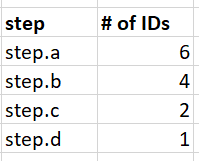Hello,
I've been working on this question for several days and can't seem to get the answer, even though it seems straight forward.
I have a table in this format, which is essentially a funnel (the numbers indicate whether they got to that step):
| ID | step.a | step.b | step.c | step.d |
|---|---|---|---|---|
| 5467894 | a | b | c | 0 |
| 2465763 | 0 | 0 | 0 | 0 |
| 3438431 | a | b | c | d |
| 4574321 | a | b | 0 | 0 |
| 5498732 | 0 | 0 | 0 | 0 |
| 4543354 | a | b | c | 0 |
| 6543245 | a | 0 | 0 | 0 |
| 4651349 | a | 0 | 0 | 0 |
I then have a statement that says GREATEST(step.a,step.b,step.c,step.d), that gives me the highest step for each ID. This is what that output looks like:
| ID | greatest |
|---|---|
| 5467894 | c |
| 2465763 | 0 |
| 3438431 | d |
| 4574321 | b |
| 5498732 | 0 |
| 4543354 | c |
| 6543245 | a |
| 4651349 | a |
So the highest step ID 5467894 gets to is step.c, 3438431 gets to step.d, 4574321 gets to step.b, etc.
What I need to show is the # of IDs that got to each step, because if an ID got to step.c, then they got to step.a and step.b as well. If an ID got to step.d, then they went through step.a, step.b, and step.c.
Looking at my 'greatest' column above, I should have the following:
| step | # of IDs |
|---|---|
| step.a | 6 |
| step.b | 4 |
| step.c | 2 |
| step.d | 1 |
For my end result, I just need to show how many IDs are in each step. I am using DataGrip and QuickSight, and I can use either to calculate the column. I don't need to use the GREATEST() command, just an idea I had. Any help would be greatly appreciated. Thank you so much.
